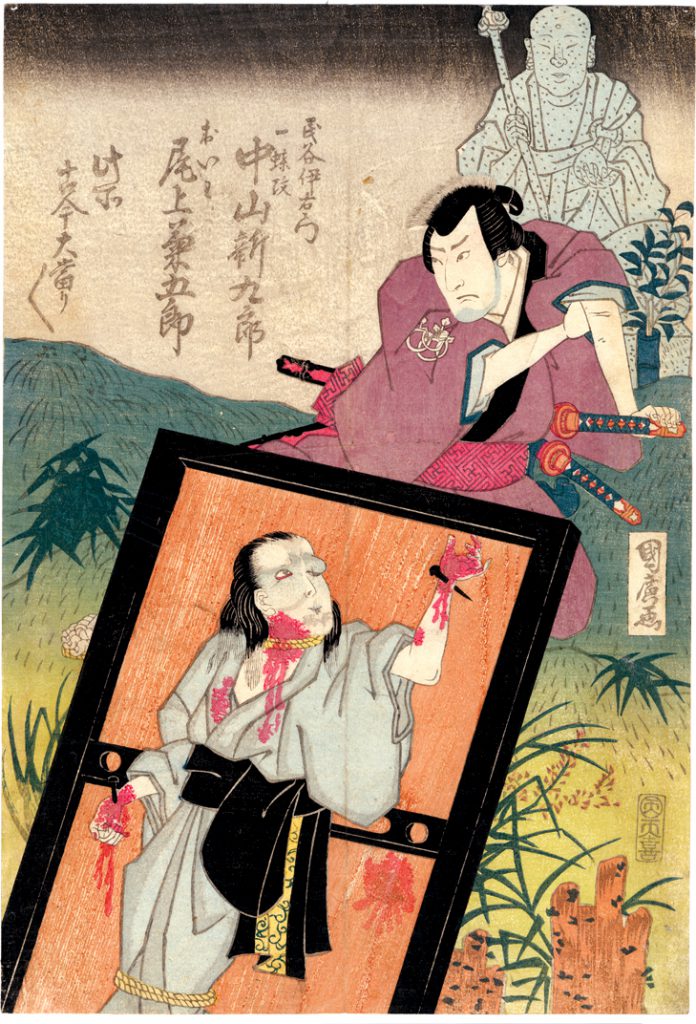Cooling down from the heat; kabuki plays in summer
June 4 (Tue), 2019 – September 1 (Sun), 2019
This museum exhibits ukiyo-e woodblock prints produced in Osaka in the Edo period. Most of the ukiyo-e prints made in Osaka were portraits of kabuki actors playing enthusiastically on the stage. And the four seasons are fully expressed by stage settings.
Today theatres are fully equipped with air conditioners so we can enjoy plays comfortably throughout the year. But in the Edo period it was so hot in kabuki theatres in summer that audience was much fewer than in other seasons. So theatres tried hard to bring in people in summer.
In this feature exhibition, we focus on kabuki plays that are performed more often in hot summer. Horror stories that let people get chills down their spine, or using real water to express coolness; please enjoy woodblock prints that depict kabuki plays that cool down the heat.

“Iroha gana Yotsuya Kaidan”, Drawn by Kunihiro
Actors: Nakayama Shinkuro playing the role of Tamiya Iemon and Onoe Kikugoro playing the role of Oiwa
Kabuki plays in summer and horror stories
There have been stories featuring spirits, ghosts or ‘mononoke’ from old times. There are kabuki plays featuring ghosts; Kanshojo becomes vengeful ghost, prostitute Oshu, the ghost, appears in Asama mono. In the late Edo period, horrific performance that makes audience shiver emerged. The blockbuster of the genre is Tokaido Yotsuya Kaidan, performed by Onoe Kikugoro III.
First staged in 1825 (Bunsei 8), melting face after taking poison, hair coming off when combing, bloodshed, and trick techiniques called ‘toita gaeshi’ (revolving door), all these scenes make us shiver just looking at them in ukiyo-e pictures. In 1826 (Bunsei 9), Onoe Kikugoro III came to Osaka and played the same story with the title of Iroha gana Yotsuya Kaidan.
Tokaido Yotsuya Kaidan
Tamiya Iemon, a masterless samurai, wanting to leave his wife, Oiwa, because she is not well after childbirth, kills Oiwa’s father and plots to divorce Oiwa and marry Oume to get a master. Oiwa is poisoned by Oume and her father and dies with face melted and hair come off. Iemon kills Kohei falsely accusing him for adultery with Oiwa, and he nails the bodies of Oiwa and Kohei to the opposite sides of a door panel and throws it into a river. Then at the wedding with Oume he kills Oume and her father, mistaking Oume for a ghost of Oiwa.
Yomoshichi, lover of Osode, Oiwa’s sister, is killed by Naosuke who loves Osode. Not knowing Naosuke killed Yoshimichi, Osode gets married to Naosuke. But after marriage Osode finds the facts that Yomoshichi is alive, and that Naosuke and Osode are siblings. Knowing the facts, Naosuke committs suicide.
Iemon, being suffured by a nightmare that beautiful Oiwa becoming a monster, finally gets killed by Yomoshichi.
Natsu Matsuri Naniwa Kagami
Kabuki play ‘Natsu Matsuri Naniwa Kagami’ is based on a true murder case. A fish seller in Sakai area was executed for a murder he committed at Nagamachi-ura.
As its title includes the word ‘natsu’, summer, this is usually played in summer. There are plentiful of Osaka summer tastes included in a play, for example, festival music of Kouzu shrine and characters in cool yukata (informal cotton kimono). It shows that the heat can play a certain role in kabuki plays. Climax of the play is a murder scene in which a man kills his greedy father-in-law to save a son of his benefactor and his lover. Real water and mud is used in this scene.
Danshichi Kurobei saves Isonojo, benefactor’s son. And he also becomes a brother-in-law with Issun Tokubei. Danshichi helps Isonojo get a job at a tools shop but Isonojo falls in love with Onaka, master’s daughter, in spite that he already has a lover, Kotoura. Danshichi’s father-in-law, wanting to get the money that a man who loves Kotoura offers, takes Kotoura out for reward. Danshichi runs after Giheiji, father-in-law, and ends up killing him.
Ideas for summer theatres
Kabuki actors in the Edo period usually made a 1 year contract with theatres. In summer there were fewer audience so many of the main actors made a provincial tour or took a vacation. While main actors were away, supporting actors were on stage with lower fee, which functioned as a gateway to success.
In addition, full-of-summer-taste plays including performance using real water, tricky performance such as midair stunts and quick change of clothes were adopted to bring in both audience and the coolness.
Summer event: nerimono, the procession
Shinmach in Osaka was one of the three biggest pleasure quarters in Japan and was bustling as well as Dotombori theatre area (cf. ‘Settsu Meisho Zue’). ‘Oiran Dochu (Courtesan Procession)’ is famous event that relates to pleasure quarter, but in summer less people visited.
So courtesans who usually wore gorgeous kimonos put on variety of costumes instead and paraded the street. This event was called ‘nerimono’, the procession. Many people came to see these women in costume and it was depicted in ukiyo-e.
Summer event: yu-suzumi, cooling off in the evening
There were theatres and show tents in Kyoto Shijo Kawaramachi area in the Edo period and it was bustling as an entertainment district. In summer, teahouses and other shops put outdoor seatings along and in the sandbanks of the Kamo gawa river to enjoy the cool breeze of the evening (cf. ‘Settsu Meisho Zue’).